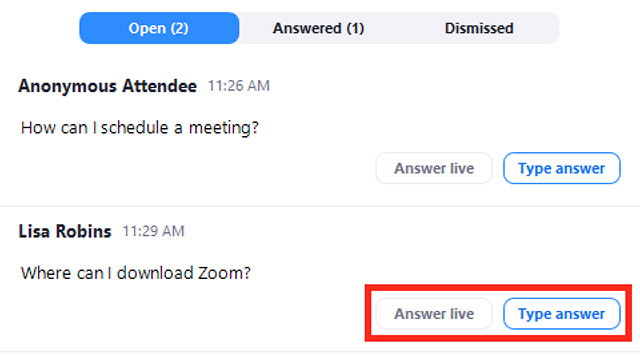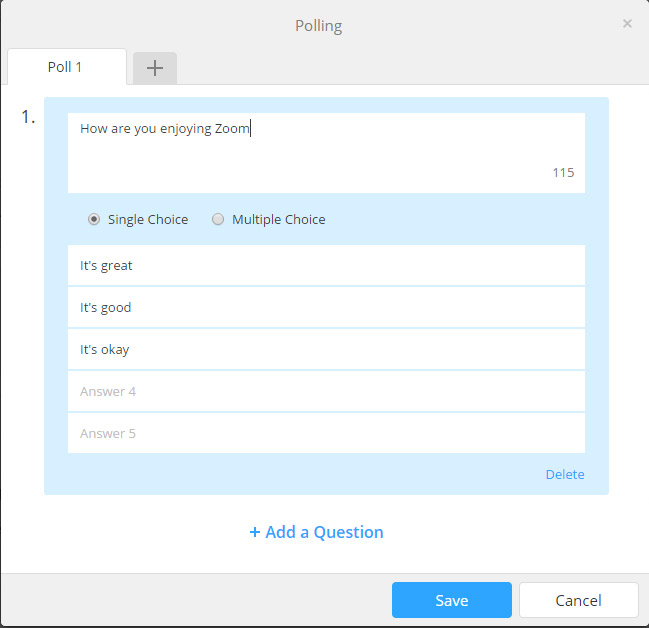Add-on Licensing for Larger Presentations
Learn about Large Meeting and Webinar licensing options for Zoom.
There are multiple Zoom licensing options for UC San Diego:
- Zoom Pro
- Large meeting
- Webinar
- Conference Room
Zoom Pro
To support the transition toward online instruction and increased telecommuting in response to Covid-19 (coronavirus) planning, we have provisioned all campus faculty, staff, teaching assistants and enrolled students with Zoom Pro accounts.
Key Features
- Host group meetings
- Up to 300 people
- Unlimited time
- One-to-one video calls are unlimited
- Customize your Personal Meeting ID
- Can be expanded with add-ons licenses
- Available for All UC San Diego faculty, staff, and students with an @ucsd.edu email address
However, for larger meetings additional licenses are required and can be purchased (see below). Please allow 3 business days before your meeting to request a Large Meeting or Webinar license.
UCSD Health
 For ALL Health-related Zoom license requests, please contact Health IS or call 619-543-HELP (x3-4357). Find more info on Pulse.
For ALL Health-related Zoom license requests, please contact Health IS or call 619-543-HELP (x3-4357). Find more info on Pulse.Large Meeting License
Large Meetings are designed to be a collaborative event with all participants being able to screen share, turn on their video and audio, and see who else is in attendance.
Large Meeting license allows up to 500 or 1000 participants, depending on license, to attend a Zoom meeting.
Annual license cost for Large Meeting:
500 participant capacity = $300/yr ea.
1,000 participant capacity = $540/yr ea.
Request the large meeting license.
Need help administering your large meeting or Webinar?
- ITS provides Zoom Webinar administration for events, lectures, meetings, and recordings.
Learn More
Webinar License
Webinars are designed so that the host and any designated panelists can share their video, audio and screen. Webinars allow view-only attendees. They have the ability to interact via Q&A, chat, and answering polling questions. The host can also unmute the attendees.
The Webinar license is scalable
- Up to 100 interactive video participants, ideal for panels
- Choose a package ranging from 500 to 10,000 view-only attendees
- 500 attendee capacity = $345 ea.
- 1,000 attendee capacity = $1,700 ea.
- 3,000 attendee capacity = $4,950 ea.
- 5,000 attendee capacity = $12,450 ea.
- 10,000 attendee capacity = $32,450 ea.
Easy sharing
- One-click HD screen sharing
- Dual screen support to show panelists and presentation at same time
Full-featured
- Host controls such as mute / unmute panelists, recording and more
- Questions and Answers dialog box with live or text answers
- Registration and post-webinar reporting
Request the Zoom webinar license.
Need help administering your large meeting or Webinar?
- ITS provides Zoom Webinar administration for events, lectures, meetings, and recordings.
Learn more
- Zoom Webinars Training Reference Guide (PDF)
- Data sheet (PDF)
- Best Practices Guide (PDF)
- FAQ (PDF)
Putting on a Webinar
When you're hosting a Zoom webinar, choosing an effective topic, being well prepared, and following some key steps will ensure it's the best experience possible for your panelists and attendees.
A Zoom webinar provides access for up to 100 panelists and up to 10,000 attendees, depending on the size of the license -- see UC San Diego Zoom webinar pricing that works best for you and your webinar needs.
Optional features allow the host to select options for managing large audiences with registration, branding, polls, Q&A, chat, recording and reporting. Here's everything you need to know about hosting Zoom webinars with tips, step-by-step instructions, and Zoom webinar best practices.
If you have any questions about getting started with Zoom, we recommend checking out:
- Our User Guide
- Zoom Webinars Training Reference Guide (PDF)
- Zoom Online Event Best Practices (PDF)
- Zoom Help Center
How to Set up Your Zoom Webinar
First things first—it's time to schedule your webinar.
You'll need to select the date, time, and topic of the webinar, and determine and invite the panelists. Webinars can require advance registration from attendees, with approval being either automatic or manual. Or Zoom webinar registration can be turned off so attendees can join without registration by clicking a link at the time of the webinar.
When choosing the link option, make sure to use tracking URLs in your social media and publicity efforts to track the best sources of attendees. Webinars can be held once, recur in a series or a weekly office hour, or the same session can be held multiple times. You can also record webinars and use them as a resource for others to watch at their leisure.
To schedule the webinar with registration, follow these steps:
1. Log In To Your Zoom Account
First, log in to your Zoom account. Once you're logged in, select "My Webinars."
2. Select "Schedule My Webinar"

Source: Zoom
First, enter the topic (webinar name) and description.
- Include who will be presenting, the subject matter, your company name, or any other descriptive info.
- Enter the date, time, and duration.
- Determine if webinar will be recurring, and if so, at what intervals.
Source: Zoom
3. Select Registration Options
Under "Invite Attendees," select edit. Attendees can be required to register via a form, and attendees are either manually approved or automatically approved. Or, attendees aren't required to register via a form. Instead, they'll simply enter their name and email information
Choose the registration option that's best for you. If you plan to follow up with attendees after the Zoom webinar, requiring them to register might be the best option. This way, you can ask custom questions on the form and learn more about them.
4. Select Q&A Settings
The Zoom webinar Q&A feature allows attendees to ask questions during the webinar. This feature can be enabled and disabled. When it's enabled, you can select an option to make the Q&A anonymous or allow attendees to see the questions.
To access the webinar Q&A settings, navigate to "Webinar Options", check "Q&A", and click "Schedule".

Source: Zoom
5. Choose Your Webinar Options
There are a few webinar options to choose from. You can:
- Automatically record the webinar
- Make webinar available on-demand
- Turn host's and panelists' video on or off
- Tip: Start the webinar with your panelists' video off so they can collect themselves before signing in.
- Require password upon sign-in
- Enable a practice session
6. Save Your Webinar as a Template
Once Registration is saved, you can save it as a template for future webinars. This works well for a weekly product demo, live roundtable, or a webinar series.
7. Publicize the Event
Your event is ready to be publicized! Copy the URL to send to attendees or share it via email, Facebook, Twitter, and other social media platforms.

Source: Zoom
Zoom Webinar Best Practices
Once the webinar has been scheduled and set up through your Zoom account, you're ready to invite attendees! Use these Zoom webinar best practices to make the most of your webinar.
1. Promote your Webinar
Use social media like Facebook and Twitter, email, and other communication tools like Teams to help spread the word about your webinar. Encourage your team members, colleagues, partners, and panelists to do the same.
Provide social media and email images to panelists and partners to make sharing as easy as possible. Check LinkedIn for relevant industry groups and invite them to attend.
2. Host a Tech Rehearsal
Once you've confirmed the panelists, it's critical to host a "dry run," particularly for folks who are new to the format. Run some test questions that you might get during the Q&A portion of the webinar and review how they can leverage features like polling to engage and interact with the audience.

Source: Zoom
Make sure PowerPoint presentations and other visuals are formatted properly and ready to go. This can be done several days before the scheduled webinar.
3. Set the Stage
Creating a visually pleasing background through the use of lighting and perhaps a canvas or screen behind the host and panelists can set a positive tone for attendees right from the start.
Be sure your hair is combed, your clothing is professional and appropriate, and get situated comfortably in front of the camera. To avoid distractions in the background, ask panelists to set up in a quiet room and use headphones if necessary.
4. Ready, Set, Go
About five minutes before your presentation begins, use the broadcast button to move from practice mode to start mode and allow attendees to join. Just before you start, take a few moments with your attendees for some "housekeeping," informing them of tools you will be using, how to ask questions, etc.
Once you've completed that task, it's time to begin! Post on social media and let your attendees know what the hashtag will be and how to follow along during the Q&A portion.
5. Keep Attendees Engaged
Nothing will cause attendees to tune out more quickly than a rambling, uninspired introduction. Keep your opening statements short and to the point, and encourage discussion early on through Q&A, polling, and hand raising, a feature allowing participants to digitally "raise their hand" to keep them focused.
Ask attendees to chat in and comment where they're tuning in from. Rather than listening to one voice for the full duration of the webinar, attendees are likely to remain more engaged if they are listening to a discussion between two or more panelists. Likewise, using clear, concise and visually pleasing slides will be much more effective in conveying your point and holding the attendees' attention.
Remain engaged throughout your time together by keeping good eye contact. Utilizing Zoom's awesome annotation tools and keeping your content visually and audibly compelling will ensure that your attendees will hang on until the end of your presentation. There, you can make your final pitch, promotion, and/or call to action.
6. Follow Up
After the webinar, find out what the attendees thought, what you can do better next time, and if you achieved your goals. Zoom provides five types of reports to help you analyze your webinar: Poll, Q&A, Attendee, Registrant, and Performance. Use this data to help dig into this event and plan for your next one. Planning regular events will help keep your audience engaged and your company's name out there, helping to not only drive revenue but build community and brand awareness as well.
So when you're ready to host your next—or maybe your first—Zoom Webinar, the bottom line is: be prepared. With advance planning and attention to even the smallest detail, you will keep your attendees engaged and anxiously awaiting your next event.
Conference Room License
Upgrade Your Conference Rooms
Request Conference room integration.
- HD Video and Audio — Put high quality video, audio and web conferencing in any sized room.
- Meet With Anyone — Include remote participants on desktop, mobile or other conference room systems.
- Wireless Sharing — Cut the cords, cables and dongles. Present content wirelessly from your laptop or mobile device.
- One Touch to Start Meeting — Start an instant meeting or integrate with your calendaring system for scheduled meetings.
- Interoperability with H.323/SIP — Communicate with any legacy endpoint, including Polycom, Cisco and Lifesize.
- Overview Status and Management — Centralized management of your conference rooms.
Software-Based Collaboration for the Conference Room
Scheduled meetings with Calendar Integration
- Google or Exchange calendar integration
- See a list of all upcoming meetings
- Upcoming meeting reminder
- One tap to start your next meeting
Touch Controls
- Meeting controls on iPad
- Host can mute/unmute participants and lock the meeting
- Invite others from directory or by email
Multi-screen video and screen sharing
- Three-screen option can show active speaker, content and gallery view (PC supports dual screen)
- Wireless screen sharing, airplay mirroring or wired HDMI content sharing
- Share content, including video clips with audio
Enhance the Experience with Touch Screens
You can easily set up your conference room with 1, 2, or 3 standard displays, or you can use a large interactive display with Zoom Rooms to help your teams brainstorm with dispersed members in a natural way. Touch Screens are perfect huddle room solutions for sharing ideas and collaborating on content with co-annotation and face-to-face video. Read more about setting up touch screens.
Learn more
Zoom rooms use H.323/SIP VOIP (voice over internet protocol) systems that are hardwired into existing conference rooms. Zoom provides a connector to work with these systems. See a list of supported devices.
- Zoom help center: H.323/SIP - Getting started, troubleshooting and FAQ from Zoom>
- Zoom Room training video (45 minutes)